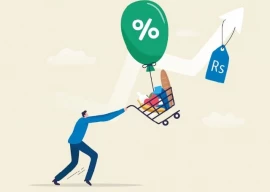
Is it really surprising that majority of Pakistanis turn to shopkeepers and suppliers when they need to borrow money?
From small loans to cope with occasional liquidity shortages to larger amounts of money, shopkeepers and suppliers across Pakistan act as the main credit providers.
In its latest annual report for 2014-15 released last week, the State Bank of Pakistan (SBP) said as many as 61% people rely on shopkeepers and suppliers for loans. In contrast, only 14% people declared formal bank loans as their primary source of credit, the central bank said while quoting statistics from the nationwide Access to Finance Survey, 2015, conducted by its consultants.
Punjab wasted $409m reforms loan, says ADB
However, the share of formal bank loans has seen a substantial increase in the last seven years. Only 3% respondents had reported bank loans as their primary source of credit in the earlier edition of the survey conducted back in 2008.
The financing structure in Pakistan relies on collateral-based borrowing, according to the SBP. Banks prefer to provide credit to corporates and fast-moving consumer goods (FMCG) manufacturers that subsequently extend credit to their dealers and wholesalers. “This line of credit indirectly cascades to the retailers, which creates a cushion against the sale of consumer goods on credit,” the SBP said in the annual report.
The survey showed “huge potential” for consumer finance in Pakistan, as only 2.4% of the entire adult population uses formal channels for borrowing.

Wasted loans
As many as 58% of all borrowing is between the ticket sizes of Rs10,000 and Rs50,000, the report adds. Going by the response of the respondents, 72% people agree that “owing money to anyone is not good”. Three-fourth of the respondents agree that “one should avoid credit” while 81% of non-borrowers say they will not borrow money in the next two to three years because of the (high) cost of credit. The survey revealed formal borrowing is “strongly positively correlated” with personal revenues, level of education and financial literacy. In addition, formal borrowing is prevented by a lack of knowledge and ease of access.
For example, informal borrowers have given many reasons for not applying for a loan at a formal financial institution. These reasons include: not knowing loan conditions (25%), lacking understanding about borrowing (24%), need to pay back other debts first (21%) and not educated enough to deal with financial institution (17%).
Microfinance institutions provide a little more than one-third of formal loans. As for informal borrowing, more than three-quarters is non-interest bearing, according to the survey.
Interest-based lending: Drive needed to create awareness of Islamic alternatives
The SBP consultants have recommended that a more accessible credit offer should be worked out, enabling people with no previous credit history to get loans at affordable costs. They also called for increasing the growth rate of the microfinance sector besides improving the overall understanding of formal borrowing procedures and conditions among the public.
Published in The Express Tribune, December 17th, 2015.
Like Business on Facebook, follow @TribuneBiz on Twitter to stay informed and join in the conversation.


1725443747-0/Untitled-design-(5)1725443747-0-165x106.webp)








1731669127-0/diddy-(44)1731669127-0-270x192.webp)




1731647129-0/Untitled-design-(56)1731647129-0-270x192.webp)






COMMENTS (2)
Comments are moderated and generally will be posted if they are on-topic and not abusive.
For more information, please see our Comments FAQ